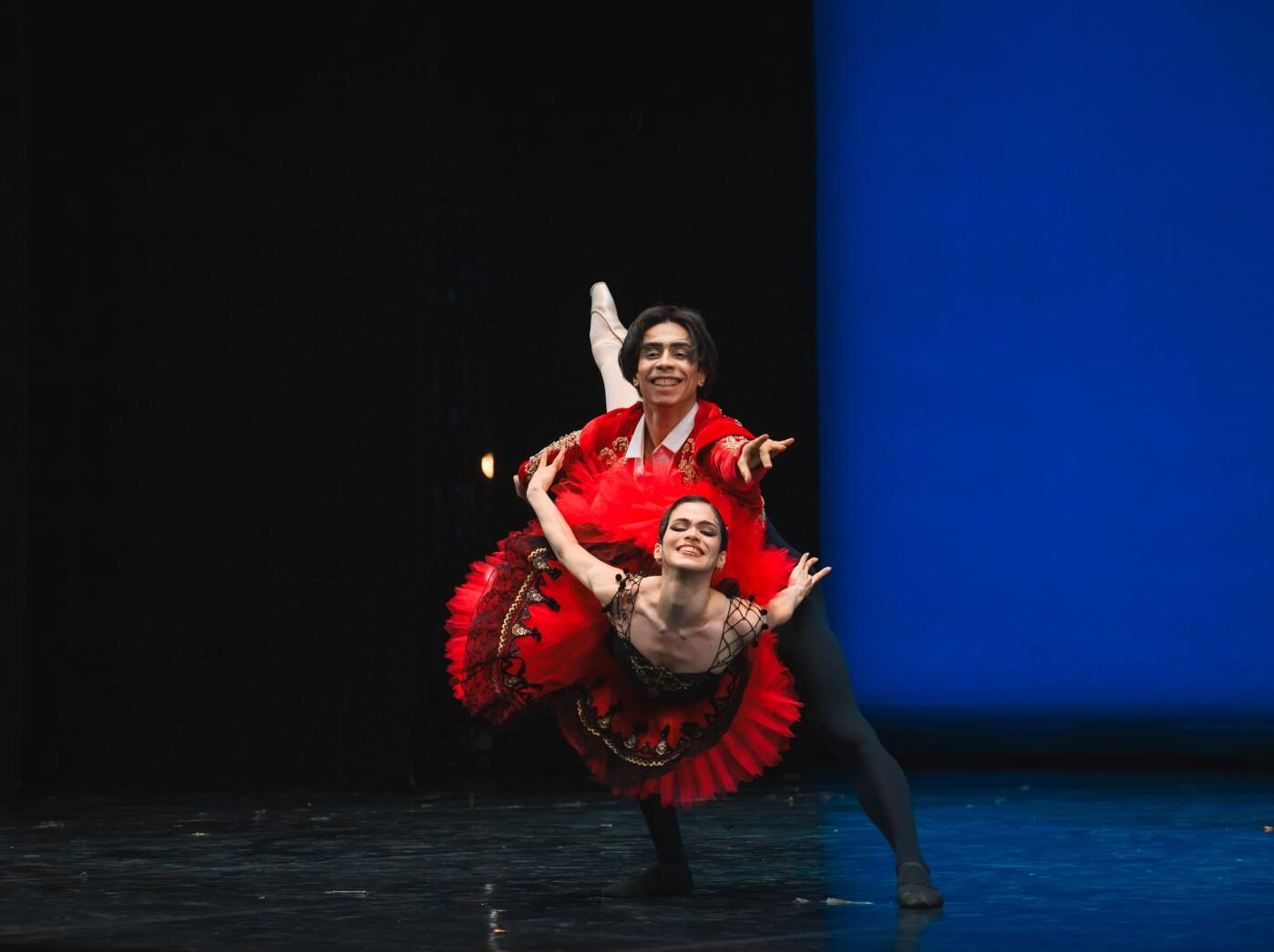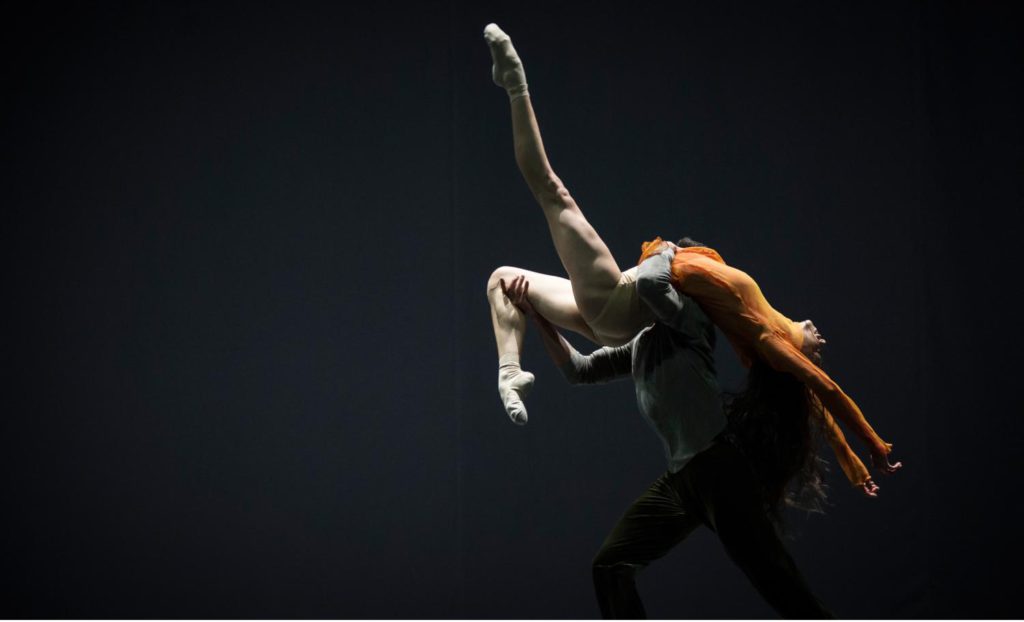“Quintett” (Triple Bill: “rituals from another when” / “Kammerballett” / “Quintett”)
Ballet Zurich
Opernhaus Zurich
Zurich, Switzerland
June 09, 2017
by Ilona Landgraf
Copyright © 2017 by Ilona Landgraf
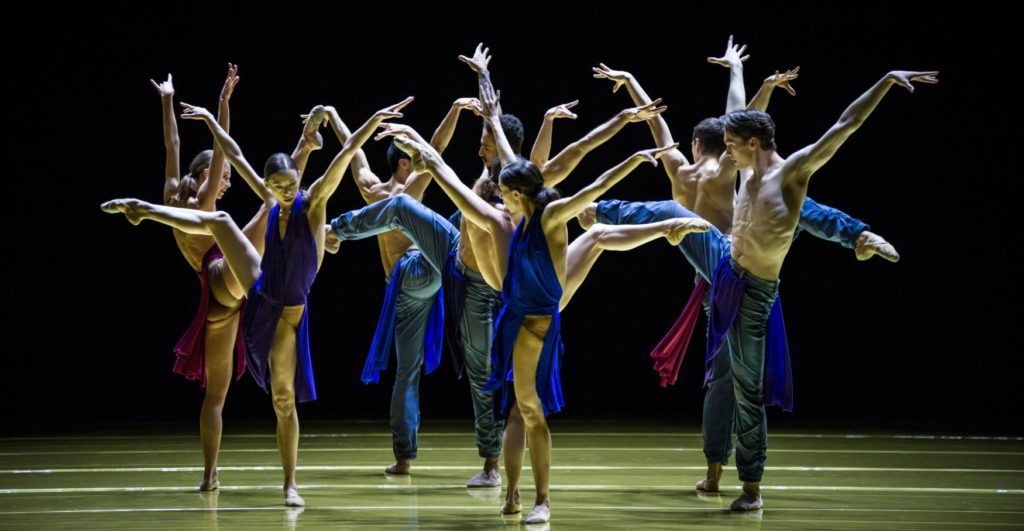 Unlike its title suggests, “Quintett”, Zurich Ballet’s mixed bill which premiered in February this year, is made of not five but three pieces. William Forsythe’s “Quintett”, rarely performed choreography from 1993, lent the evening its caption. The other two ballets were “rituals from another when,” a new creation for Zurich Ballet by Jacopo Godani, and Hans van Manen’s “Kammerballett.” All three pieces were danced to recorded music.
Unlike its title suggests, “Quintett”, Zurich Ballet’s mixed bill which premiered in February this year, is made of not five but three pieces. William Forsythe’s “Quintett”, rarely performed choreography from 1993, lent the evening its caption. The other two ballets were “rituals from another when,” a new creation for Zurich Ballet by Jacopo Godani, and Hans van Manen’s “Kammerballett.” All three pieces were danced to recorded music.
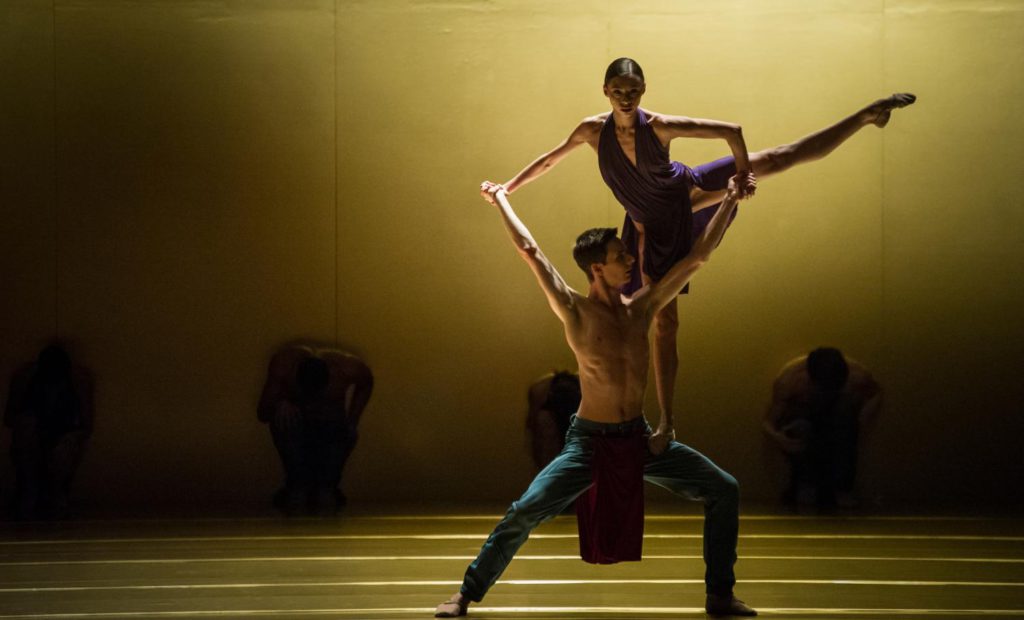 Godani succeeded Forsythe as artistic director and choreograph of Dresden Frankfurt Dance Company in 2015. His ballet was the opener. Godani took charge of everything himself: choreography, set and costume design and lighting. Of the eight dancers included, the four women wore leotards in purple, bright pink, blue and black and sometimes black pants; the four men wore jeans with bare chests. Both men and women had two pieces of cloth from the same color palette draped around their waists, deeply slit on both sides like skirts. The costumes contrasted strongly with the mustard yellow, box-like space the
Godani succeeded Forsythe as artistic director and choreograph of Dresden Frankfurt Dance Company in 2015. His ballet was the opener. Godani took charge of everything himself: choreography, set and costume design and lighting. Of the eight dancers included, the four women wore leotards in purple, bright pink, blue and black and sometimes black pants; the four men wore jeans with bare chests. Both men and women had two pieces of cloth from the same color palette draped around their waists, deeply slit on both sides like skirts. The costumes contrasted strongly with the mustard yellow, box-like space the 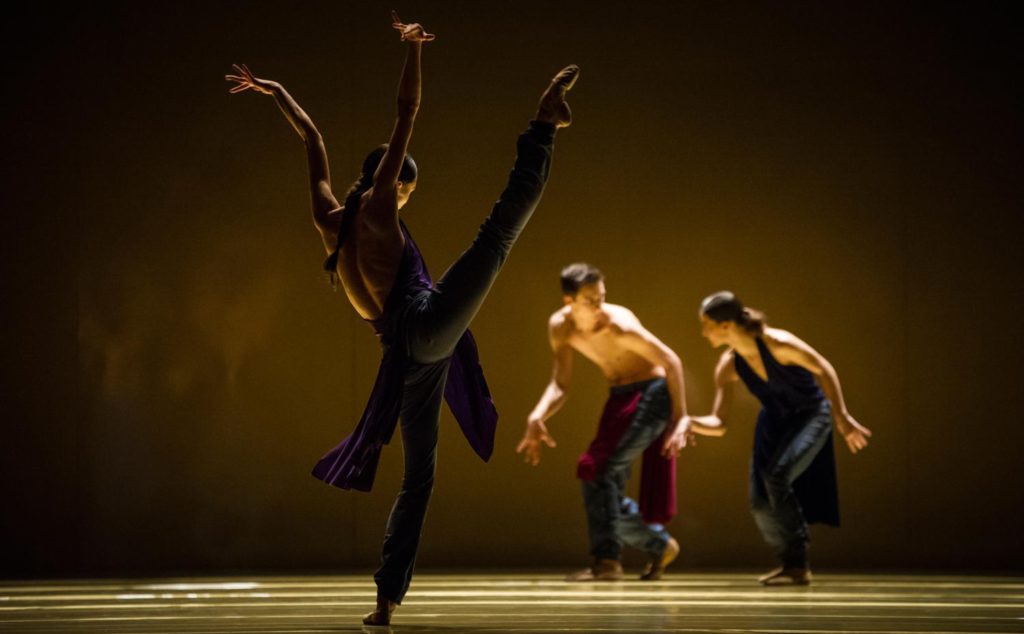 stage resembled. Later the backdrop changed to black, while the yellow decor remained on both sides. Lighting – warm or cool and either from the front or from behind – added to the play with contrasts.
stage resembled. Later the backdrop changed to black, while the yellow decor remained on both sides. Lighting – warm or cool and either from the front or from behind – added to the play with contrasts.
Several times the light was switched off and on, each time revealing other scenes with dancers in different formations. The music, electronic sounds with a monotonous rhythm by 48nord, had several mini pauses. With the right timing, such visual and acoustic embedding even made a simple développé visually special. Plain routines for the group – raised arms, crossing legs, little jumps, hip swings – also looked interesting.
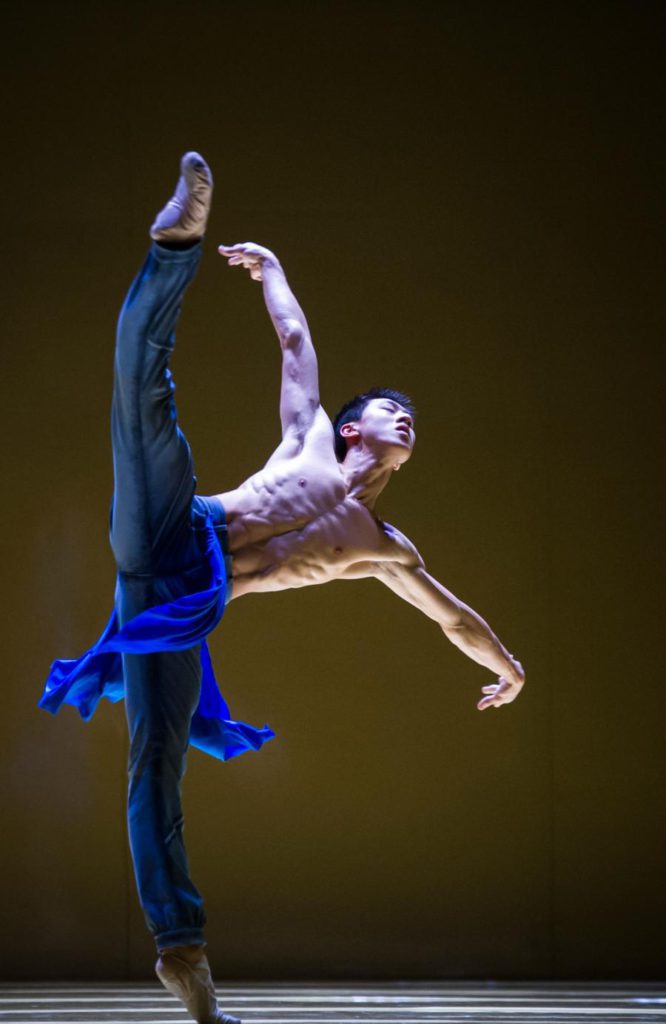 Godani’s most memorable choreographic idea was a hopping walk with bend knees, slightly hunched shoulders and dangling arms whose bounciness made one think that the dancers’ bones were made of rubber. Other movement elements included catwalk-like strutting, frozen poses, sudden angular shifts and undulations running through the whole body like forceful waves. Occasionally, components of classical ballet were woven into the contemporary language, which had the same casualness and free flow the entire choreography radiated.
Godani’s most memorable choreographic idea was a hopping walk with bend knees, slightly hunched shoulders and dangling arms whose bounciness made one think that the dancers’ bones were made of rubber. Other movement elements included catwalk-like strutting, frozen poses, sudden angular shifts and undulations running through the whole body like forceful waves. Occasionally, components of classical ballet were woven into the contemporary language, which had the same casualness and free flow the entire choreography radiated.
In an interview in the program booklet, Godani mentioned the movements of big cats, particularly the amount of power they generate with a small amount of muscular tension, as one source of inspiration. When one male dancer on all fours watched Constanze Perrota Altube’s solo from the background, one indeed thought of an animal observing the goings-on from the undergrowth, whereas another solo was reminiscent of a funny Walt Disney-version of an animal hopping around.
“rituals from another when” ended with Anna Khamzina embracing Jesse Fraser while the other six dancers crouched in line along the backdrop.
“Kammerballett,” set to music by Kara Karajew, Domenico Scarlatti and John Cage, is more than twenty years old. It seemed 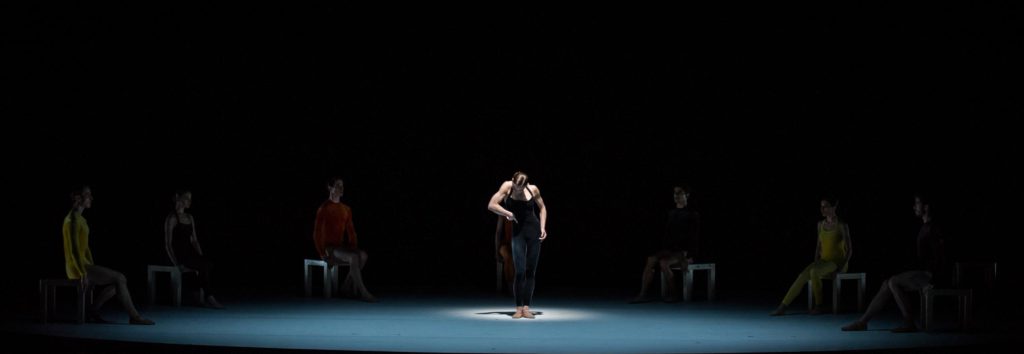 modest compared to the array of effects Godani relied on. Modest and much stronger. The only prop the four male / female couples used was a wooden stool for each one. It served as a seat or as a tool for simple movements. Later, one woman pushed her partner down from his stool, but then caught him as he attempted to sit down where no stool was anymore. Later he did the same to her, earning a cold look after their pas de deux finished. From the beginning, when each one searched for a place to put down their stool, much about the group’s social texture had been revealed.
modest compared to the array of effects Godani relied on. Modest and much stronger. The only prop the four male / female couples used was a wooden stool for each one. It served as a seat or as a tool for simple movements. Later, one woman pushed her partner down from his stool, but then caught him as he attempted to sit down where no stool was anymore. Later he did the same to her, earning a cold look after their pas de deux finished. From the beginning, when each one searched for a place to put down their stool, much about the group’s social texture had been revealed.
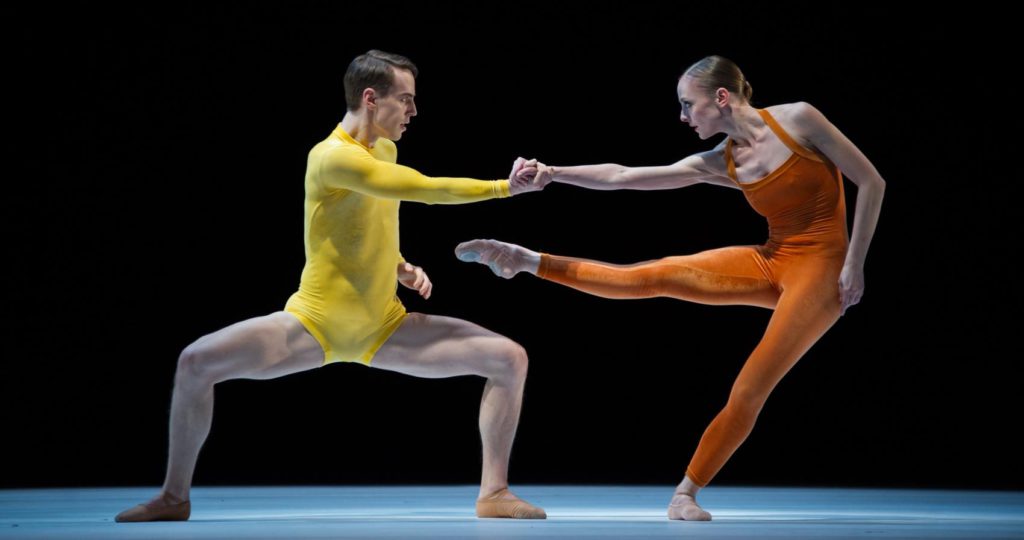 The lighting defined an ellipse in which solos and pas de deux took place. Keso Dekker’s unfussy color design consisted of simple monochrome costumes in orange, yellow, brown or black; the backdrop and drapes masking the wings were black too.
The lighting defined an ellipse in which solos and pas de deux took place. Keso Dekker’s unfussy color design consisted of simple monochrome costumes in orange, yellow, brown or black; the backdrop and drapes masking the wings were black too.
In comparing Van Manen’s piece with Godani’s, one basic difference was strikingly apparent. Whereas Godani draws attention to moves and poses themselves, those are secondary in “Kammerballett.” Van Manen employs steps to transport meaning, create an atmosphere and reveal layers beyond the surface, and he does so with seemingly simple means. He needs no decoration, no extras to 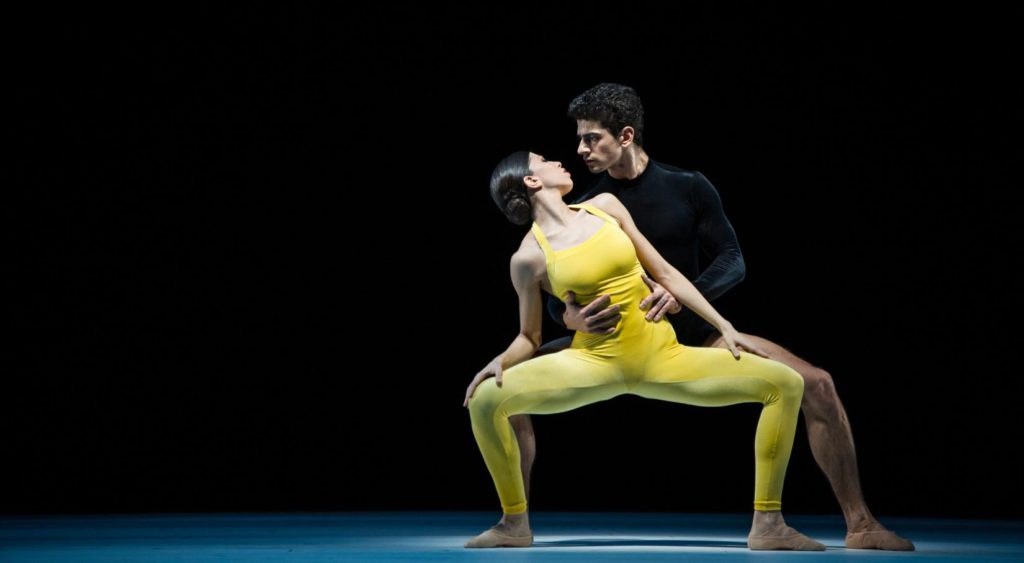 unfold a microcosm of psychological mini-studies which are trenchant and witty. William Moore’s faint smile, for example, disclosed immediately that he had a superior position, was amused by the others and wouldn’t get worked up no matter what. One disapproving glance by Katja Wünsche quickly identified her as the bitchy boss. She danced the final solo, during which all others picked up their stools and left the stage. Wünsche depicted a mannish woman who almost aggressively bid defiance to the group but in a pas de deux with Moore also had moments of weakness. Finally left alone, she pulled herself together before
unfold a microcosm of psychological mini-studies which are trenchant and witty. William Moore’s faint smile, for example, disclosed immediately that he had a superior position, was amused by the others and wouldn’t get worked up no matter what. One disapproving glance by Katja Wünsche quickly identified her as the bitchy boss. She danced the final solo, during which all others picked up their stools and left the stage. Wünsche depicted a mannish woman who almost aggressively bid defiance to the group but in a pas de deux with Moore also had moments of weakness. Finally left alone, she pulled herself together before 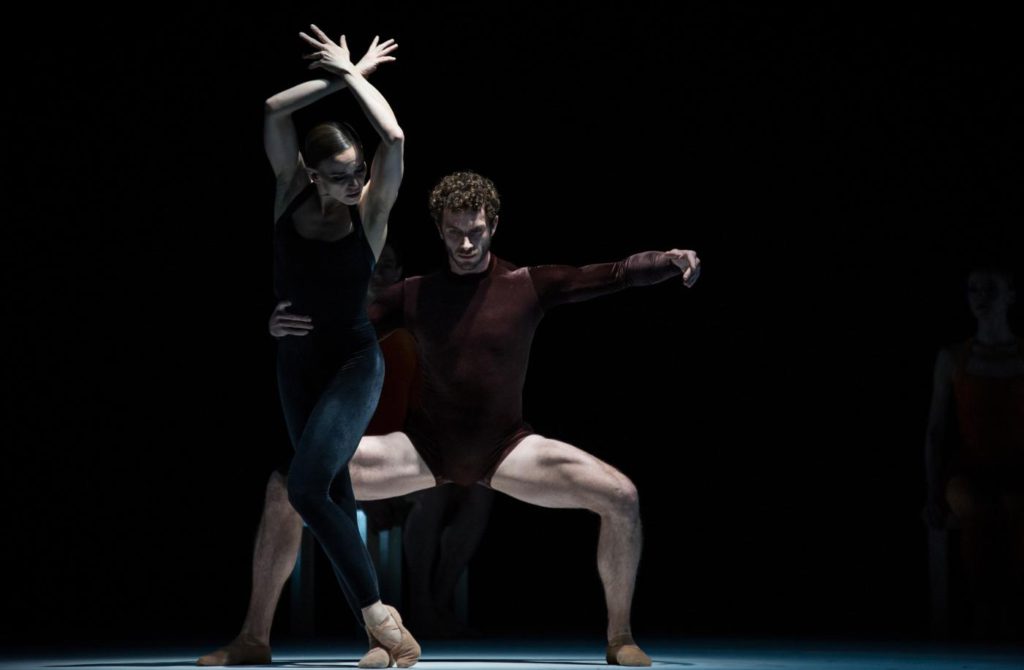 walking offstage.
walking offstage.
Hans van Manen turns eighty-five this summer. Dutch National Ballet will celebrate his birthday throughout the entire season, beginning with the opening gala on September 12th and, later in September, continuing with a mixed bill made of four Van Manen pieces including one world premiere.
Having experienced Forsythe’s choreography as either technically stylized and emotionally distant or oozing with weird humor, I was surprised by the natural vitality and warmth of “Quintett.” Is that due to the imprint of Forsythe’s co-choreographers Dana Caspersen, Stephen Galloway, Jacopo Godani, Thomas 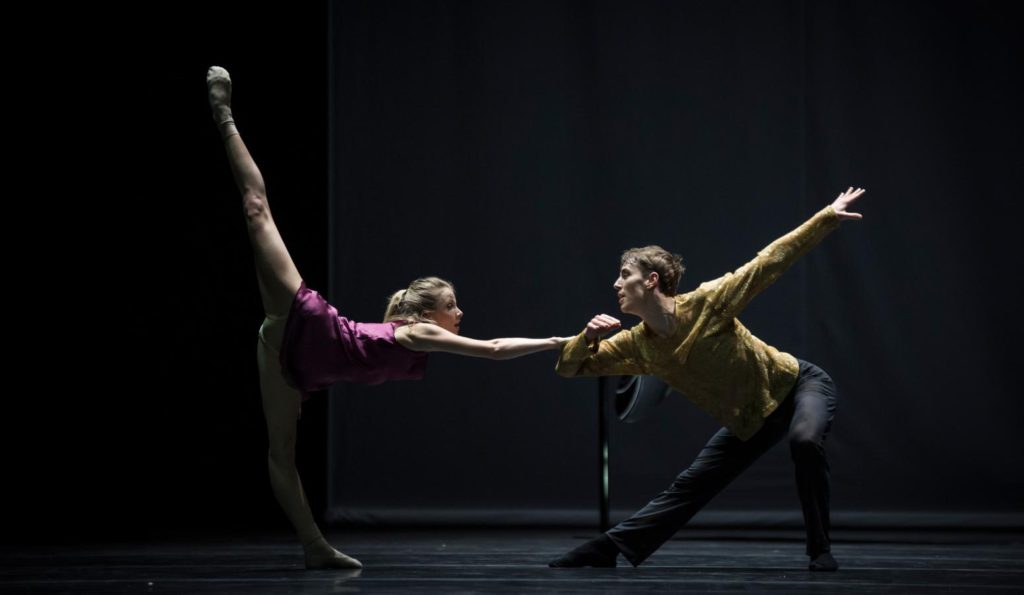 McManus and Jone San Martin? More likely the piece is special because it is an homage to the dancer Tracey-Kai Maier, Forsythe’s wife, who was severely ill during the time “Quintett” was created. She died before its premiere. The five dancers of the original cast were all closely connected to her.
McManus and Jone San Martin? More likely the piece is special because it is an homage to the dancer Tracey-Kai Maier, Forsythe’s wife, who was severely ill during the time “Quintett” was created. She died before its premiere. The five dancers of the original cast were all closely connected to her.
As Forsythe explained in an interview in Zurich Ballet’s program booklet, “Quintett” rarely enters the repertory of companies because it needs “hybrid dancers,” dancers with a wide technical and stylistic spectrum on top of a classical training foundation. In Zurich those were 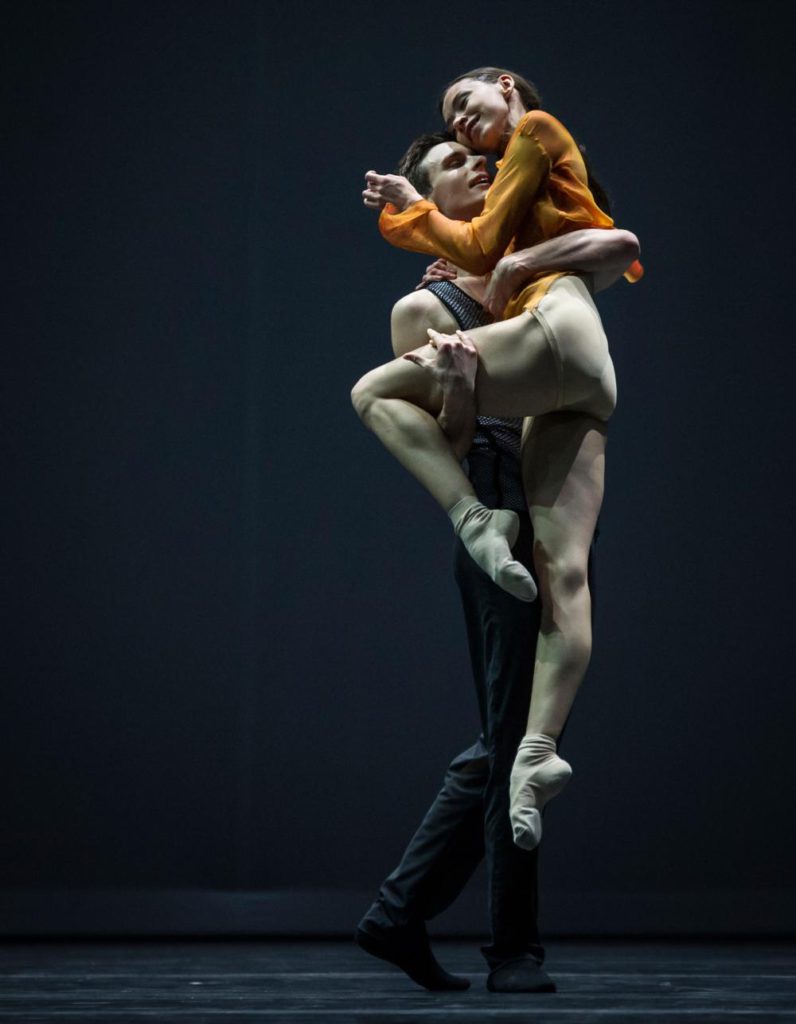
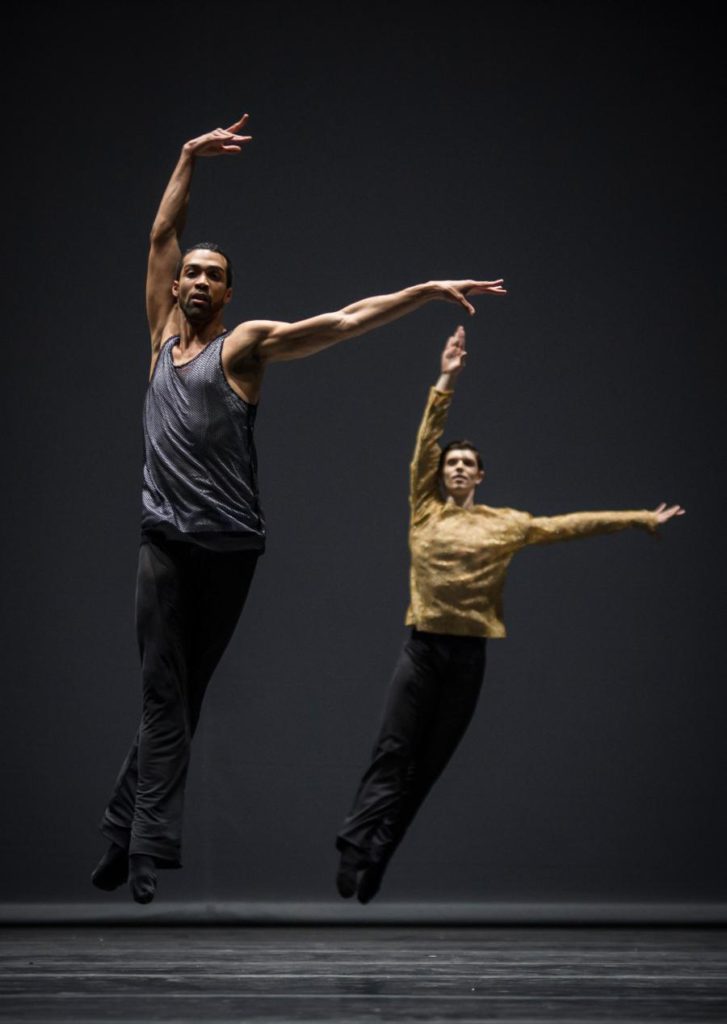 Giulia Tonelli, Katja Wünsche, Matthew Knight, Dominik Slavskovský and Tars Vandebeek. I actually waited the entire time for a sixth person to appear, the man singing the short hymn “Jesus’ blood never failed me yet,” which in an endless loop accompanied the dancers. His voice, sounding distant at the beginning, seemed to come closer and closer, but he never turned up in person.
Giulia Tonelli, Katja Wünsche, Matthew Knight, Dominik Slavskovský and Tars Vandebeek. I actually waited the entire time for a sixth person to appear, the man singing the short hymn “Jesus’ blood never failed me yet,” which in an endless loop accompanied the dancers. His voice, sounding distant at the beginning, seemed to come closer and closer, but he never turned up in person.
Given its background one might expect “Quintett” to be a heavy-hearted, somber piece, but except for some hints of melancholy the opposite was true. The dance was bubbly, generous, daring and on occasions quite humorous. Once, for example, a dancer ended sitting on the floor while partnering his ballerina. His momentum had transferred into her turn, and 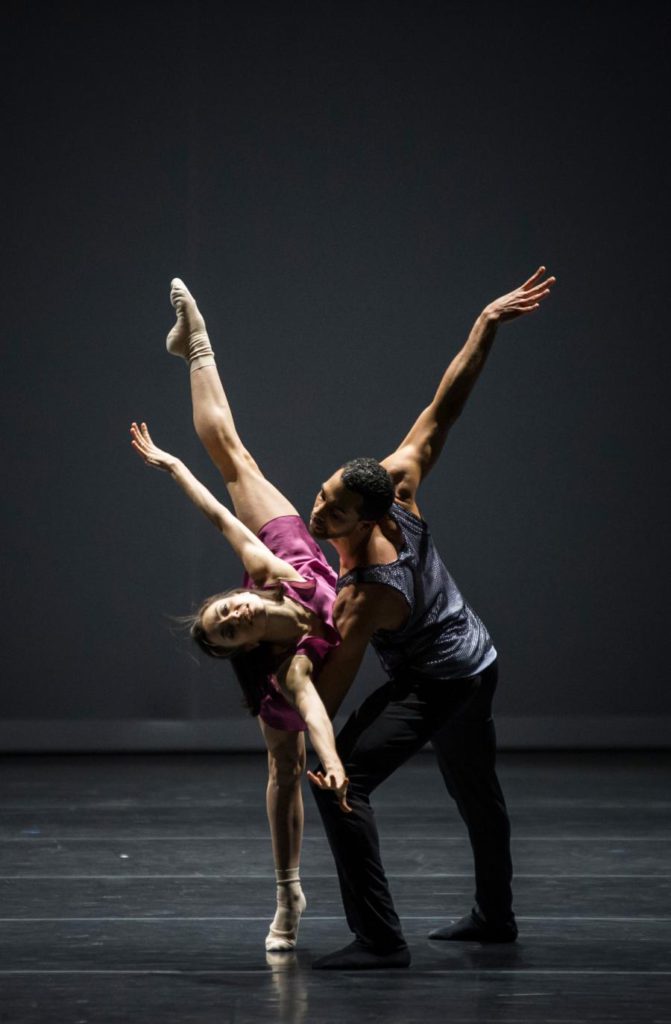
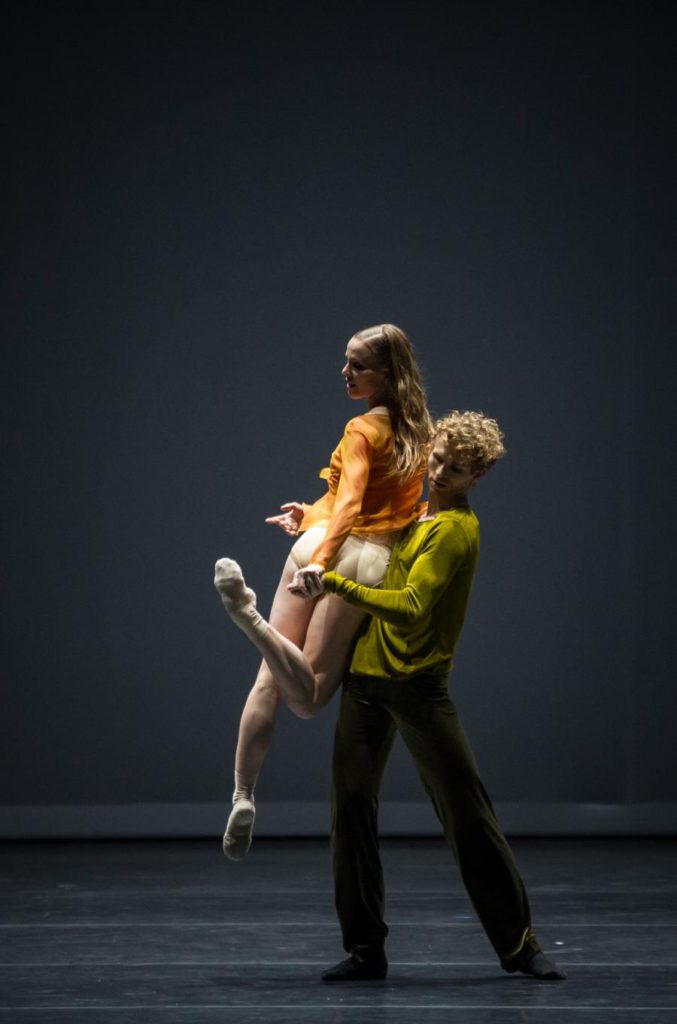 as if devoid of any energy his feet abruptly slipped away. It looked like a beginner ice skater falling onto his bottom. In other scenes Tonelli, on all fours, unashamedly stuck her bottom up like a little girl and Wünsche marveled at the golden light generated by a huge projector machine center stage. She positioned herself right into the beam of light, walked backwards and suddenly was pushed over by the light.
as if devoid of any energy his feet abruptly slipped away. It looked like a beginner ice skater falling onto his bottom. In other scenes Tonelli, on all fours, unashamedly stuck her bottom up like a little girl and Wünsche marveled at the golden light generated by a huge projector machine center stage. She positioned herself right into the beam of light, walked backwards and suddenly was pushed over by the light.
From time to time one dancer disappeared in or appeared from a rectangular pit at the rear of the stage. Through a standing mirror next to the edge of this pit, one could see a small staircase leading downwards. Forsythe suggested in the interview mentioned above it might be a grave, but when seeing Vandebeek’s curly shock of hair popping 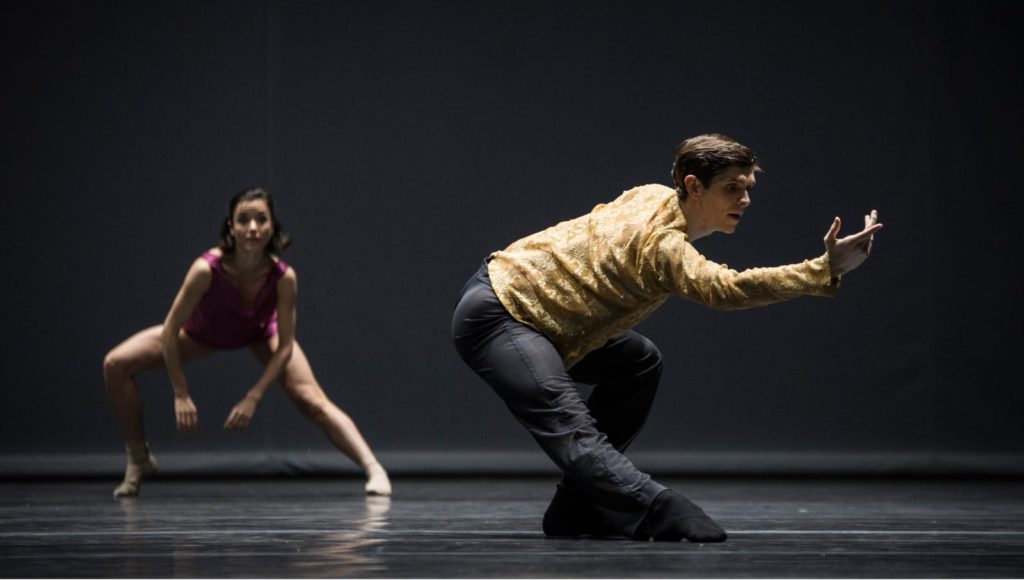 up from it on one occasion, I rather thought of a puck curiously observing the dancers from his near-ground outlook.
up from it on one occasion, I rather thought of a puck curiously observing the dancers from his near-ground outlook.
The choreography’s unpredictability and its ignorance towards conventions made it captivating. Small movement impulses such as a gentle push initiated speedy, powerful moves; bold off-balance positions ended in beautiful phrases; The women, above all Tonelli, lunged fearlessly towards the arms of their partners trusting they would be caught at the last moment.
“Quintett” received much applause. Deservedly so.
| Links: | Website of Ballet Zurich | |
| Trailer “Quintett” | ||
| Rehearsal “rituals from another when” (video) | ||
| Rehearsal “Kammerballett” (video) | ||
| Rehearsal “Quintett” (video) | ||
| Photos: | (The photos show a partially different cast from an earlier performance.) | |
| “rituals from another when” (Jacopo Godani) | ||
| 1. | Ensemble and Junior Ballet Zurich, “rituals from another when” by Jacopo Godani, Ballet Zurich 2017 | |
| 2. | Anna Khamzina and Jan Casier, “rituals from another when” by Jacopo Godani, Ballet Zurich 2017 | |
| 3. | Anna Khamzina, Jan Casier and Mélissa Ligurgo, “rituals from another when” by Jacopo Godani, Ballet Zurich 2017 | |
| 4. | Wei Chen, “rituals from another when” by Jacopo Godani, Ballet Zurich 2017 | |
| “Kammerballett” (Hans van Manen) | ||
| 5. | Katja Wünsche and ensemble, “Kammerballett” by Hans van Manen, Ballet Zurich 2017 | |
| 6. | Daniel Mulligan and Mélanie Borel, “Kammerballett” by Hans van Manen, Ballet Zurich 2017 | |
| 7. | Constanza Perrota Altube and Tigran Mkrtchyan, “Kammerballett” by Hans van Manen, Ballet Zurich 2017 | |
| 8. | Katja Wünsche and William Moore, “Kammerballett” by Hans van Manen, Ballet Zurich 2017 | |
| “Quintett” (William Forsythe et al.) | ||
| 9. | Michelle Willems and Daniel Mulligan, “Quintett” by William Forsythe, Ballet Zurich 2017 | |
| 10. | Manuel Renard and Matthew Knight, “Quintett” by William Forsythe, Ballet Zurich 2017 | |
| 11. | Anna Khamzina and Jan Casier, “Quintett” by William Forsythe, Ballet Zurich 2017 | |
| 12. | Giulia Tonelli and Manuel Renard, “Quintett” by William Forsythe, Ballet Zurich 2017 | |
| 13. | Katja Wünsche and Tars Vandebeek, “Quintett” by William Forsythe, Ballet Zurich 2017 | |
| 14. | Giulia Tonelli and Matthew Knight, “Quintett” by William Forsythe, Ballet Zurich 2017 | |
| 15. | Tigran Mkrtchyan and Anna Khamzine, “Quintett” by William Forsythe, Ballet Zurich 2017 | |
| all photos © Carlos Quezada | ||
| Editing: | Tiffany Lau |
